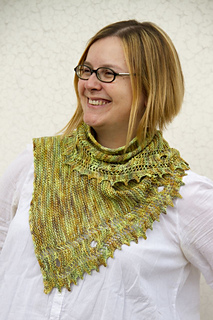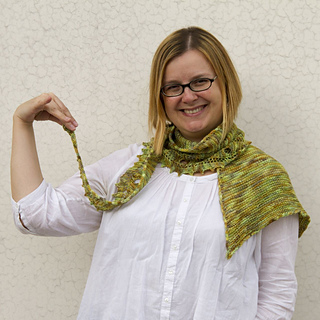patterns >  Artherapy
Artherapy
> Salvària







Salvària
Pattern available in English and in Italian.
“Salvària” is part of the new collection of patterns inspired by the “Monti Pallidi (Pale Mountains)”, a chain of mountains in the Italian Dolomites.
The “Salvàrie” were sylvan women who lived in the woods and rocks above the Badia and Fassa Valleys. They tended to avoid civilazation; being wise and benevolent creatures, they ate nuts and berries and they could see everything that happened around them, even those things that men would have preferred to keep secret.
Every once in a while, a Salvària would marry a man from the valley, but she could never reveal her real name. If, by chance, her husband discovered her real name, she was forced to abandon her husband and children forever.
“Salvària” is a small, asymmetric shawl with an unusual shape. It is knit in garter stitch and has an i-cord border that hugs the body when the shawl is wrapped around the neck and shoulders. The wide, reversible lace border is reminiscent of large “eyes” that symbolize the wisdom of the Salvària who sees and knows all.
Because of its unusual shape and the way it is knit, it can be made in a variety of sizes, depending on how much yarn you have!
Finished measurements:
99 cm – 39 inches along the longer side and 37 cm – 14.5 inches along the shorter side (before blocking).
180 cm – 71 inches along the longer side and 60 cm – 23.5 inches along the shorter side (after blocking).
Yarn and needles:
Woolisa Merino Wool (100% wool: 420 m – 460 yards for 125 gr – 4.40 ounces skein), 1 skein.
Needles 4 mm – US 6.
Other notions:
Tapestry needle.
1 stitch marker.
Gauge:
22 sts x 42 rows = 10 cm – 4” in garter stitch (before blocking).
14 sts x 26 rows = 10 cm – 4” in garter stitch (after blocking).
In fact the gauge is not very important in this pattern. Since the knitting starts from the narrow end of the shawl, it is easy to adjust the length based on how much yarn you have.
Instead, final blocking is important: the shawl must be blocked rather aggressively to reach the desired length and to allow the lace border to “open up”!
………………………………
Pattern disponibile in italiano ed in inglese.
“Salvària” fa parte della nuova collezione ispirata ai “Monti Pallidi”, la catena montuosa delle Dolomiti italiane.
Le Salvàrie (o “donne della selva”) erano delle donne selvagge che abitavano i boschi e le rocce sopra la val Badia e la val di Fassa. Tendevano a schivare gli uomini, anche se, sagge e benevole, si nutrivano di frutti di bosco e vedevano tutto, anche le cose che gli uomini avrebbero voluto restassero nascoste.
Ogni tanto succedeva che una Salvària sposasse un uomo della valle ma non svelava mai il suo vero nome. Se il marito per caso lo scopriva, la Salvària era costretta ad abbandonare per sempre marito e figli.
Lo schema “Salvària” è un piccolo scialle asimmetrico con una forma insolita. È realizzato a maglia legaccio ed ha un bordino lavorato con l’I-cord per avvolgersi meglio attorno al collo ed alle spalle. Il grande bordo in pizzo reversibile disegna dei grandi “occhi” che simboleggiano la saggezza della Salvària che vede e sa tutto.
A causa della sua forma è possibile realizzarlo in varie misure, a seconda della disponibilità di filato che si possiede!
Dimensioni finite:
99 cm lungo il lato più lungo e 37 cm lungo il lato più corto prima del bloccaggio.
180 cm lungo il lato più lungo e 60 cm lungo il lato più corto dopo il bloccaggio.
Filato e aghi:
Woolisa Merino Wool (100% lana: 420 m per matassa da 125 gr), 1 matassa.
Aghi numero 4 mm.
Altro:
Ago da lana.
1 marcapunto.
Campione:
22 m x 42 ferri = 10 cm a legaccio prima del bloccaggio.
14 m x 26 ferri = 10 cm a legaccio dopo il bloccaggio.
In realtà il campione non è molto importante perché, incominciando dal vertice più stretto, è possibile regolare in modo molto semplice la lunghezza dello scialle a seconda di quanto filato si possiede. E’ essenziale, invece, la fare finale del bloccaggio, anche piuttosto aggressivo, per permettere allo scialle di allungarsi fino alla sua misura finale e per permettere al bordo in pizzo di “aprirsi”!
Photo Courtesy: Paolo Bonivento
Grazie a Donna per la traduzione in inglese!
- First published: June 2014
- Page created: June 10, 2014
- Last updated: August 9, 2017 …
- visits in the last 24 hours
- visitors right now





